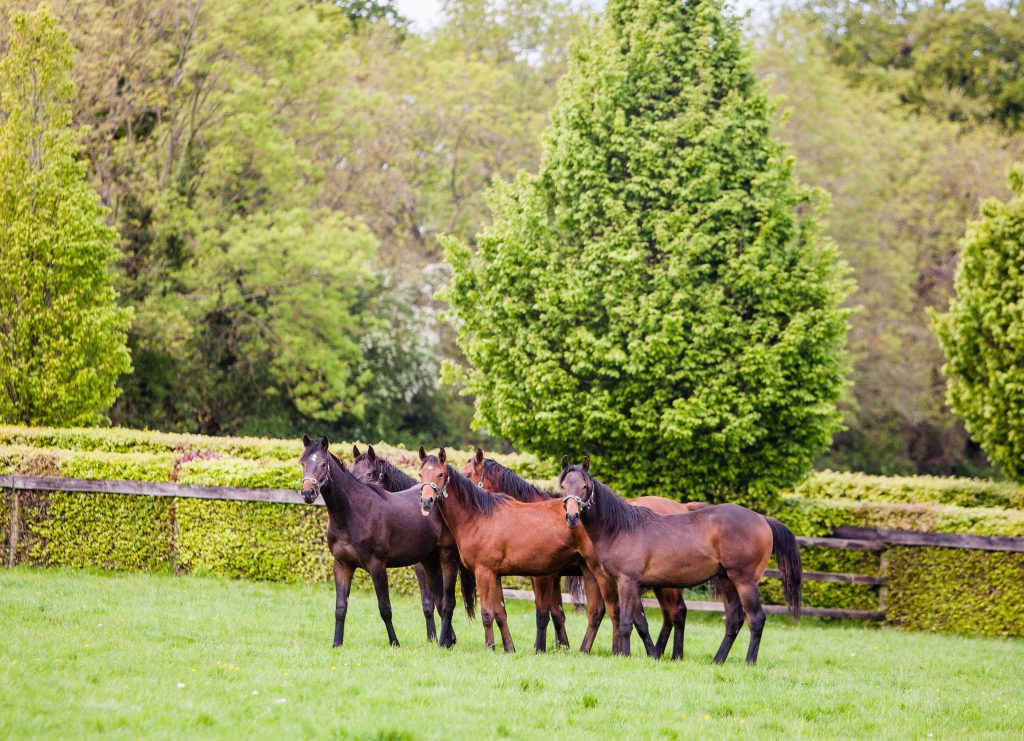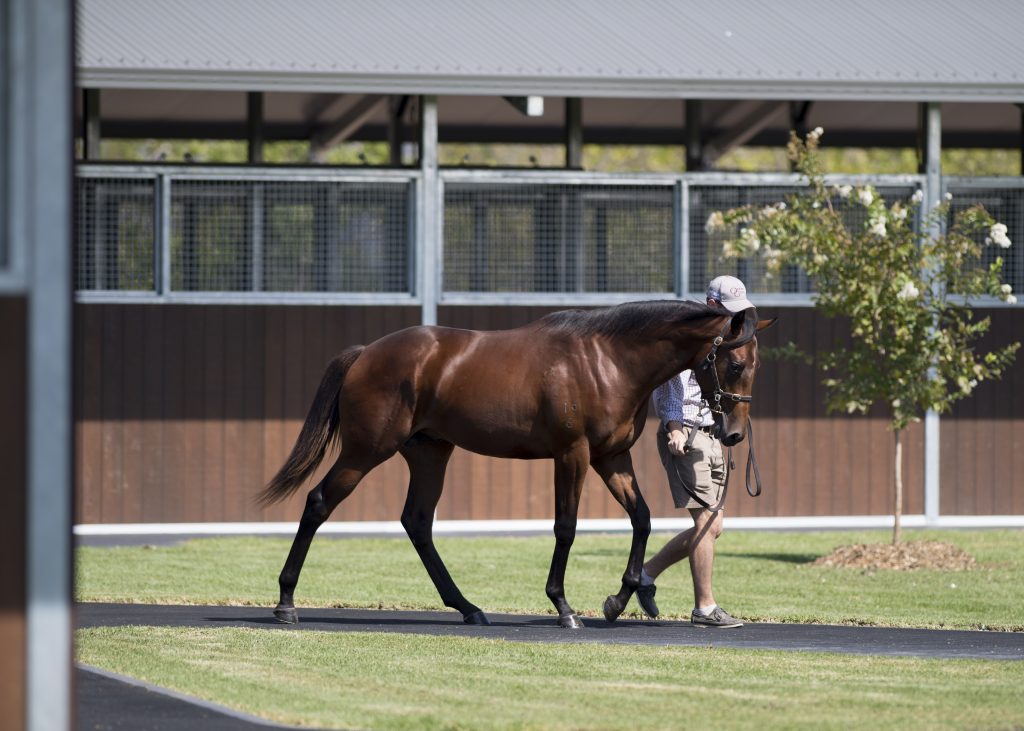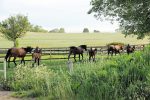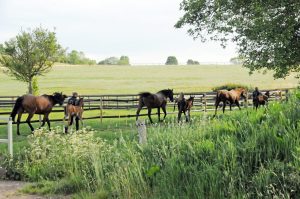The old saying “Fail to prepare and prepare to fail” is true in all walks of life, and most definitely applies to the preparation of yearlings for their commercial ‘moment of truth’ in the sales ring.
Methods differ from consignor to consignor and horse to horse, but one would imagine that certain trends prevail, particularly when it comes to their base, whether it be Europe, North America or the southern hemisphere. To examine the worldwide differences, or similarities, we spoke to leading international consignors and, from the very outset, the contrast is vast in the numbers each prepare for the yearling sales.
Of those asked, top Australian operation Arrowfield Stud leads the way at 230 yearlings each season, though it is not a million miles ahead of Kentucky’s Taylor Made Sales at 175. David Cox, who will consign solely as Baroda Stud for the first time this year, is next in line by consigning 100, the same number as St George Sales, although on average it preps 65 of those it offers.
La Motteraye, the up-and-comers of the French sales scene, quoted 60 or so yearlings, with an extra handful joining them at the sales ground. The same number was given by Cambridge Stud, Sir Patrick Hogan’s legendary New Zealand nursery recently acquired by Brendan and Jo Lindsay.
Whatton Manor Stud, which enjoyed perhaps a career-best sale at Tattersalls in 2018, preps 40 to 45 yearlings for sales in England, Ireland and France. Completing our analysis is Norelands Stud, which boasts a rich heritage of producing top class horses, and which focuses on quality at 20 to 25 yearlings annually.
All begins with feeding
Mark Taylor of Taylor Made Sales Agency believes that feed is the most important element of the sales prep process.
“Our belief is that the most critical part of sales preparation is done on the inside through proper nutrition and a healthy gut,” he says.
Taylor Made switch horses from a pelleted ration to a sweet feed mix for this period.
“The prep feed has a higher fat content from oil and beet pulp,” he says. “This fat is good for adding weight, energy and a great haircoat. Our yearlings also get cooked flax seed on top of their grain. Most of them love this treat in the afternoon and it is another source of healthy fat to help them shine.”
Each farm reminds me that every horse is treated as an individual and their feeding regime is no different. In fact, Whatton Manor’s Ed Player cites changes to its feeding methods as a huge help in 2018.
“We changed our feed company to Saracen in 2017,” he says. “And I have to admit our feeding programme has become far more complex. Our yearlings get hugely different feeding programmes depending on lots of different factors and Polly Bonner of Saracen has been hugely helpful.”
Gwen Monneraye and Lucie Lamotte of La Motteraye place so much importance on feed that they have created their own mix.
“We have made a specialist feed with our nutritionist, who is also a vet and he is very dedicated to the farm,” says Monneraye. “The yearlings also have a lot of small meals throughout the day to prevent gastric problems.”

Yearlings at David Cox’s Baroda Stud – Photo: Baroda Stud
Baroda, meanwhile, caters to individual yearlings’ needs with various additions to its standard use of stud cubes, prep mix, cool feed and balancers.
“Some might need supplements, copper, calcium, and Transvite probiotics,” he says. “We also have to build up their immune systems as they will be going to sales complexes and travelling on lorries, etc, and so Equiton tonic, garlic and honey is used.”
Katy Smith, yearling manager at Cambridge Stud, is another who amends their feeding regime with added supplements.
“Additives for coat health such as Livamol, joint health and increased protein in Equi-Jewel and milk powder are added,” she says, “based on the condition of individual yearlings.” That’s not the only change, however, as she explains. “Due to them being stabled we increase the total amount of fibre in their diets both through hay and additional fibre in their evening feed,” she adds.
In contrast, Arrowfield concentrates on increasing the level of protein in its yearlings’ diets to balance the increased workload, while St George Sales doubles the yearlings’ feed consumption.
Norelands Stud is another which “keep it simple” in the words of manager Matt Gilsenan, by increasing quantities in accordance with workload and uses hard feed, Karron oil and high-quality haylage.
Variety in exercise key
Physical exercise is another element which each consignor adapts depending on the individual, though all but one uses a combination of the horse walker, hand-walking and lunging.
Unsurprisingly, facilities have a huge effect on the physical prep, as highlighted by Baroda’s David Cox. “Handling is huge for us,” he says. “We are lucky to have two yards, as well as an isolation yard, so that we can prep the colts and fillies separately. This year, we will also be able to prep yearlings in the UK in a top farm in Warwickshire, which is a great addition to the consignment.”
Not far away, Norelands makes use of its beautiful surroundings in County Kilkenny.
“We try to hand-walk all yearlings a couple of days a week through the woods to teach them to drop their heads and this is fine until sales get close and they get fitter,” says Gilsenan. “As with putting them in driving reins and rollers, it’s labour intensive and so it’s a selective process.”
Katy Smith revealed an intriguing aspect to the yearling prep at Cambridge Stud. “These days I think we would be one of the few farms to not exercise our horses,” she says. “They get a good length of walk out to their paddocks and this is all they get. They obviously get parade practice, but they are not put on walkers or lunged, or introduced to tack. The horses are a blank canvas and what you see with them is what you get, natural muscle and all.”
Although Cambridge Stud recently changed hands, this practice remains true to the farm’s heritage, as Smith explains. “Most of the methods still used today at Cambridge Stud are the original methods; the old saying of ‘if it ain’t broke, don’t fix it’ being very true.”
Switching Stateside, both St George Sales and Taylor Made use swimming as part of the prep process. Mark Taylor explains that a huge part of the Taylor Made focus is keeping their horses happy and this begins at the start of the day. “We actually meet the yearlings at the gate of their field with a bucket of feed to reward them for being at the gate each day,” he says.
The devil is indeed in the detail and Taylor lists other idiosyncrasies.
“After exercise each horse is curried while they are still warm,” he says. “They will shed better with their elevated body temperature and the rub down is a type of massage which they enjoy. Then comes a quick hose down to remove any sweat and dirt. We try not to use soap on their coats more than once or twice a week because it tends to strip the coat of natural oil and makes them dull.”
That’s not all. “Late afternoon we go through and mud their legs with poultice,” says Taylor. “This helps keep their young joints cool and tight. It’s also the best fly repellant, which keeps them from stomping flies that can trigger epiphysitis and chipped hooves.”
The most common length of time to prep given by consignors was eight weeks, although some individual horses may differ. Some other farms spend ten weeks on prep, including Arrowfield and Whatton Manor, while La Motteraye alot this period to those yearlings entered in earlier sales. Taylor Made gave the longest period, allowing 90 days of prep for the Keeneland September Sale entries.
Internationalisation
Asked how the sales prep process has changed over the years, the majority of consignors cited increased standards across the board.
“The yearling prep has become a lot more professional over the last ten to 15 years,” says Lucie Lamotte. “The difference may be even greater in France, as since Arqana was created, a new generation of experienced people have arrived here with new methods and are very keen to prove we can also do a good job in France.”
Gwen and Lucie hit on an interesting point, in that in this new world of easy travel the bloodstock markets have merged – European breeze-up consignors source many of their yearlings in the US, while American agents often visit Europe to access new bloodlines, and so on. As each market aspires to attract the biggest buyers, they also must adapt to the expectations of those potential clients.
Another influence on the internationalisation of the industry is the travel of staff, who bring with them methods from their home place, and, in turn, learn new methods on their travels.
Archie St George of St George Sales is a perfect example of how international experience is worth its weight in gold, with the Kilkenny native growing up in the jump racing scene before studying at Cirencester in England. From there, he went on to work for ten years at Eaton Sales in Kentucky, where he now runs Brooklodge Farm with his wife Michelle.
“Our methods have evolved over time, taking into consideration previous work experience and standard techniques used by many in the area,” he says. “We hope to provide a standard of excellence across the board while tailoring to the specific needs of each horse.”

Photo: Bronwen Healy
Whatton Manor’s Ed Player is another who was, and still is, keen to learn from others.
“My father [Peter Player] has been prepping yearlings for longer than I have been alive so he has always had great methods in place,” he says. “Before I came back to the farm I did a season prepping yearlings at Lynn Lodge for Eddie O’Leary, where I learnt a huge amount. They were masters of prepping a very large number of yearlings to high standards with very few staff. They operated a hugely efficient routine and their horses always look great.
When I came back to Whatton my father and I tweaked how we did things; we continue to do this every year as we pick up new ideas. I am always fascinated to hear how other farms do things and try to take the best bits from all of them and mould them to our routine.”
And how have these various influences changed the finished article at the sales? Baroda’s David Cox says: “I believe that yearlings tend to be more toned and muscled these days, which is down to advanced nutrition and the yearlings being fitter.”
Mark Taylor is in agreement. “I think the market now rewards a good sized yearling that moves really well and looks healthy with lean muscle,” he says. “This is what we are striving for.” That wasn’t always the case, as he explains: “If you go back to photos of yearlings from the early 1980s you will be shocked at how fat they look! Back then the market wanted them fat and that look was what sold.”
Cambridge Stud is a farm renowned for its rich heritage and Katy Smith doesn’t believe that the market requests necessarily benefit the animals.
“I think there has been an increase in the level in which the horses are exercised,” she says. “Don’t get me wrong, they need to have a base fitness to be able to cope with the demand of the yearling sales, but sometimes I feel this is maybe taken too far. Some horses are basically broken in before arriving at the sales complex.
“They are young horses and sometimes it’s nice to see the horse as a horse. Maybe I’m wrong in that; that is what buyers are wanting these days – ready-made athletes who look ready to hit the track.”
Matt Gilsenan is another who mourns the changing demands of the market. “The greatest challenge when prepping yearlings is that sales have become beauty pageants,” he says. “You need perfect x-rays and scopes for a yearling without a blemish, which is difficult after the first 18 months of its life, as they fight for supremacy and feed!”
Gilsenan, however, does have a suggestion as to why buyers are seeking the perfect specimen, saying: “We now mainly sell to agents, who struggle to overlook any faults as they are spending someone else’s money!”
The quest for perfection, just like with humans, now sees a growing number of thoroughbreds go under the knife, which is one of the biggest problems in the industry, according to Mark Taylor.
“When buyers come to the sale they will shy away from a horse with an inconsequential P1 chip in an ankle,” he says. “I would estimate that the number of yearlings which had joint surgery in 1985 was around 10%. My estimation is that in 2019 approximately 30% of yearlings have had a joint surgery. It could be higher than that.”
Surgery has a detrimental effect on a yearling’s routine, he explains, saying: “All these surgeries force the yearling to be locked up in the stall at some point between January and June of their yearling year. This is the prime time for them to be outside and not confined to a stall. This puts the horse behind and causes a slew of other issues related to stress and stall confinement. I wish the industry would move away from the emphasis on pristine vet reports.”
Arrowfield’s Paul Messara highlighted another challenge facing sales consignors. “The greatest challenge we face in sales prep is ensuring we have high quality leaders to show our horses in the best possible light at the yearling sales,” he says.
That view is echoed by Ed Player – a mountain of hard work can be undone at the sales without the right team. “It is crucial to get a great team of people to show them at the sales,” he says. “Without this you have wasted 18 months of hard work getting them to the sale.”
Of course, it’s not just at the sales that staff play a huge role. “Luckily we have a fantastic team at home who are prepared to go the extra yard, whether that is changing rugs at 10pm or something similar,” he adds. “It is these things that differentiate your yearlings from others at the sales.”



